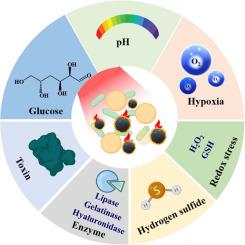内源性刺激活化光热疗法治疗细菌感染。
IF 9.6
1区 医学
Q1 ENGINEERING, BIOMEDICAL
引用次数: 0
摘要
光热疗法作为一种非侵入性的治疗方法,近年来在对抗细菌感染方面受到越来越多的关注。当暴露在光下时,光热剂将光能转化为热,产生局部热疗,有效地消除传染性病原体。然而,以高温为基础的治疗容易对周围的正常组织造成损害。为了提高光热疗法的抗菌效果,同时尽量减少副作用,研究人员开发了可活化的光热剂,以应对特定的感染微环境触发因素,如酸性pH值、氧化还原水平升高和过表达酶。感染部位的特定物理化学因素调节光热剂的激活(开/关开关)或触发辅助治疗模式,同时增加细菌对光热治疗的敏感性,同时优化生物安全性和治疗特异性。因此,在本文中,我们首先回顾了目前治疗细菌感染的挑战,并阐述了光热抗菌治疗的基本原理和优势。总结了2020-2025年可活化光热剂抗感染应用的最新进展。最后,我们讨论了光热活化剂在抗感染治疗中的挑战和未来发展。重要意义声明:细菌感染仍然是人类健康的主要威胁,推动了光热抗菌治疗的重大兴趣。然而,传统的光热治疗通常依赖于热疗,这可能会不加选择地损害周围的健康组织。为了最大限度地提高抗菌效果,同时最大限度地减少脱靶效应,开发对感染微环境有反应的智能光热剂已成为一项关键的研究挑战。本文概述了刺激活化光热剂的关键设计策略,重点介绍了该领域的最新进展,并讨论了当前的局限性以及未来的前景。本文章由计算机程序翻译,如有差异,请以英文原文为准。

Endogenous stimuli-activatable photothermal therapy for bacterial infections
Photothermal therapy, a non-invasive treatment approach, has attracted growing attention in recent years for combating bacterial infections. When exposed to light, photothermal agents convert light energy into heat, generating localized hyperthermia that effectively eliminates infectious pathogens. However, hyperthermia-based treatments are prone to cause damage to the surrounding normal tissue. To enhance the antibacterial efficacy of photothermal therapy while minimizing side effects, researchers have developed activatable photothermal agents that respond to specific infection microenvironment triggers, such as acidic pH, elevated redox levels, and overexpressed enzymes. The specific physicochemical factors at the infection site modulate the activation of photothermal agent (on/off switching) or trigger auxiliary therapeutic modalities, simultaneously increasing bacterial susceptibility to photothermal treatment while optimizing biosafety and therapeutic specificity. Therefore, in this review, we first examined the current challenges in treating bacterial infections and elucidated the fundamental principles and advantages of photothermal antibacterial therapy. Then, the recent advancements (2020–2025) in activatable photothermal agents for anti-infection applications were summarized. Finally, we deliberated on the challenges and future development of activatable photothermal agents in anti-infective therapies.
Statement of significance
Drug-resistant bacterial infections remain a major threat to human health, driving significant interest in photothermal antibacterial therapy. However, conventional photothermal treatments often rely on hyperthermia, which can indiscriminately damage surrounding healthy tissues. To maximize antibacterial efficacy while minimizing off-target effects, the development of smart photothermal agents responsive to infectious microenvironments has emerged as a critical research challenge. This review outlines key design strategies for stimuli-activated photothermal agents, highlights recent advances in the field, and discusses current limitations along with future prospects.
求助全文
通过发布文献求助,成功后即可免费获取论文全文。
去求助
来源期刊

Acta Biomaterialia
工程技术-材料科学:生物材料
CiteScore
16.80
自引率
3.10%
发文量
776
审稿时长
30 days
期刊介绍:
Acta Biomaterialia is a monthly peer-reviewed scientific journal published by Elsevier. The journal was established in January 2005. The editor-in-chief is W.R. Wagner (University of Pittsburgh). The journal covers research in biomaterials science, including the interrelationship of biomaterial structure and function from macroscale to nanoscale. Topical coverage includes biomedical and biocompatible materials.
 求助内容:
求助内容: 应助结果提醒方式:
应助结果提醒方式:


